一般现在时态
- 格式:doc
- 大小:35.50 KB
- 文档页数:3
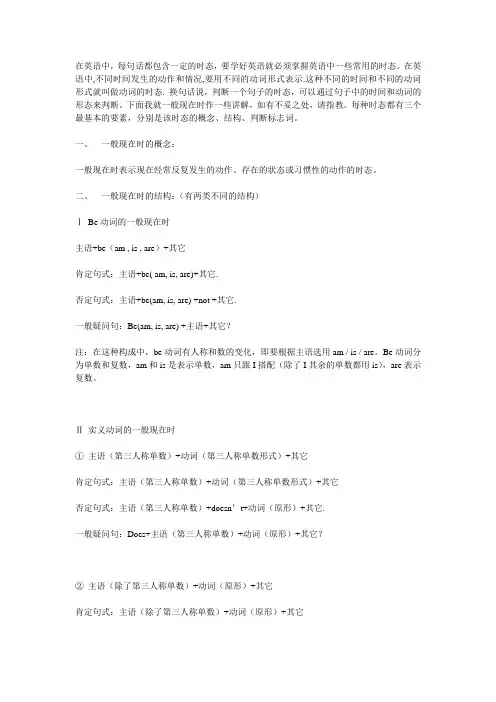
在英语中,每句话都包含一定的时态,要学好英语就必须掌握英语中一些常用的时态。
在英语中,不同时间发生的动作和情况,要用不同的动词形式表示.这种不同的时间和不同的动词形式就叫做动词的时态. 换句话说,判断一个句子的时态,可以通过句子中的时间和动词的形态来判断。
下面我就一般现在时作一些讲解,如有不妥之处,请指教。
每种时态都有三个最基本的要素,分别是该时态的概念、结构、判断标志词。
一、一般现在时的概念:一般现在时表示现在经常反复发生的动作、存在的状态或习惯性的动作的时态。
二、一般现在时的结构:(有两类不同的结构)ⅠBe动词的一般现在时主语+be(am , is , are)+其它肯定句式:主语+be( am, is, are)+其它.否定句式:主语+be(am, is, are) +not +其它.一般疑问句:Be(am, is, are) +主语+其它?注:在这种构成中,be动词有人称和数的变化,即要根据主语选用am / is / are。
Be动词分为单数和复数,am和is是表示单数,am只跟I搭配(除了I其余的单数都用is),are表示复数。
Ⅱ实义动词的一般现在时①主语(第三人称单数)+动词(第三人称单数形式)+其它肯定句式:主语(第三人称单数)+动词(第三人称单数形式)+其它否定句式:主语(第三人称单数)+doesn’t+动词(原形)+其它.一般疑问句:Does+主语(第三人称单数)+动词(原形)+其它?②主语(除了第三人称单数)+动词(原形)+其它肯定句式:主语(除了第三人称单数)+动词(原形)+其它否定句式:主语(除了第三人称单数)+don’t+动词(原形)+其它.一般疑问句:Do+主语(除了第三人称单数)+动词(原形)+其它?注:do、don’t和does、doesn’t是构成一般现在时的助动词,其特点是要在其后跟动词的原形。
三、一般现在时的判断标志词often , usually , always , sometimes , at times , once a day , every + 时间四、动词的第三人称单数的构成规则和发音规则:1. 一般在动词后直接加上-s。
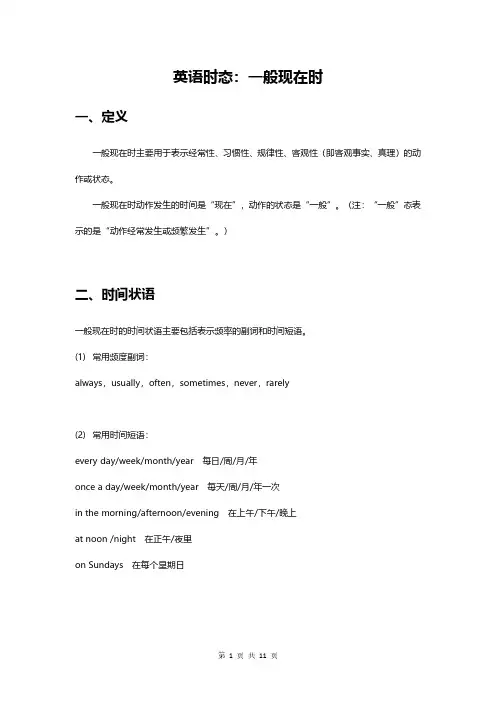
英语时态:一般现在时一、定义一般现在时主要用于表示经常性、习惯性、规律性、客观性(即客观事实、真理)的动作或状态。
一般现在时动作发生的时间是“现在”,动作的状态是“一般”。
(注:“一般”态表示的是“动作经常发生或频繁发生”。
)二、时间状语一般现在时的时间状语主要包括表示频率的副词和时间短语。
(1)常用频度副词:always,usually,often,sometimes,never,rarely(2)常用时间短语:every day/week/month/year每日/周/月/年once a day/week/month/year每天/周/月/年一次in the morning/afternoon/evening在上午/下午/晚上at noon/night在正午/夜里on Sundays在每个星期日三、动词形式主语不是第三人称单数时,谓语动词采用动词原形。
主语为第三人称单数时,谓语动词需采用第三人称单数形式。
动词第三人称单数变化形式主要包括以下几种情况:(1)大多数实义动词直接在词尾加s。
清辅音后加s发音为/s/,浊辅音后加s发音为/z/。
示例:speak-speaks/s/work-works/s/arrive-arrives/z/come-comes/z/(2)以o,s,x,ch,sh结尾的动词在词尾加es。
o后加s发音为/z/,其他几个后面加s发音为/iz/。
示例:do-does/z/go-goes/z/pass-passes/iz/fix-fixes/iz/watch-watches/iz/wash-washes/iz/(3)以辅音加y结尾的动词,把y改成i,再加es,发音为/z/。
(注:元音加y结尾的动词,只加s即可,发音为/z/,如play-plays,stay-stays。
)示例:carry-carries/z/hurry-hurries/z/(4)不规则情况(这类词需单独记忆)。
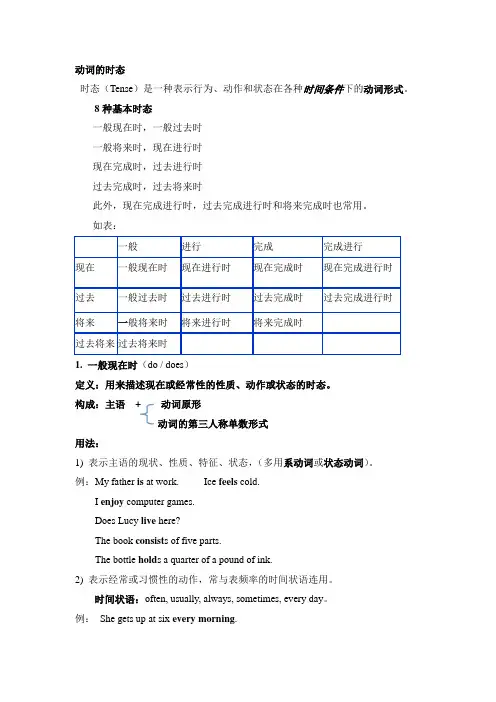
动词的时态时态(Tense)是一种表示行为、动作和状态在各种时间条件下的动词形式。
8种基本时态一般现在时,一般过去时一般将来时,现在进行时现在完成时,过去进行时过去完成时,过去将来时此外,现在完成进行时,过去完成进行时和将来完成时也常用。
如表:1. 一般现在时(do / does)定义:用来描述现在或经常性的性质、动作或状态的时态。
构成:主语+ 动词原形动词的第三人称单数形式用法:1) 表示主语的现状、性质、特征、状态,(多用系动词或状态动词)。
例:My father is at work. Ice feels cold.I enjoy computer games.Does Lucy live here?The book consist s of five parts.The bottle hold s a quarter of a pound of ink.2) 表示经常或习惯性的动作,常与表频率的时间状语连用。
时间状语:often, usually, always, sometimes, every day。
例:She gets up at six every morning.I often go to school on foot.We always care for each other and help each other.3) 表示客观事实或普通真理(不受时态限制)。
例:The geography teacher told us the earth moves around the sun.Three plus three is six.Actions speak louder than words. 行动胜过言语。
4) 一般现在时表示将来a)表示按计划,规定要发生的动作,仅限于少数动词如come、go、leave、arrive、fly、return、start、begin、open、close、end、stop等。

一般现在时态英语语法中的时态(tense)是一种动词形式,不同的时态用以表示不同的时间与方式。
是表示行为、动作、状态在各种时间条件下的动词形式,在英语中有16种时态。
一般现在时:表示通常性、规律性、习惯性的状态或者动作(有时间规律发生的事件)的一种时间状态。
常与一般现在时连用的时间状语:daymorningafternoon⑴every系列eveningweekmonthYearAlwaysAlmost alwaysusuallyoften⑵频度副词sometimes →用以回答how often(经常Hardly ever 与否)这样问题的副词SeldomrarelyNeverOncetwicethree times⑶次数Twice a weekthree times a weekOn saturdaysOn sundays一、一般现在时态的用法1、表示经常、反复发生或者习惯性的动作。
如:We have three meals every day. 我们每天吃三餐饭.2、表示现在或者经常存在的状态。
如:He is at table. 他在吃饭。
I am usually at home at this time of day. 白天这个时候我通常在家。
3、表示主语具备的性格、能力和本质特性等。
如:She likes watching TV. 她喜欢看电视。
We speak Chinese. 我们说汉语。
4、表述客观事实、普遍真理、名言、警句或者谚语,谚语等。
如:The earth goes around the sun.地球绕着太阳转。
Every dog has its day. 凡人皆有得意日。
5、表述按时间表已经拟定或者安排好了要发生的动作或事情。
此时常见的动词有:arrive, begin, come, go, leave, return, run, start等。
句子中一般还有表示将来的时间状语。
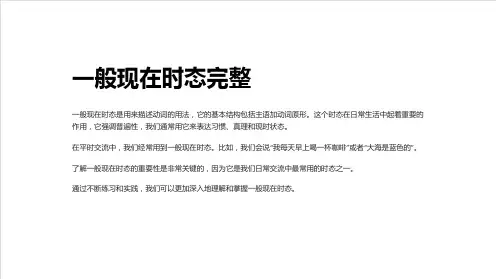
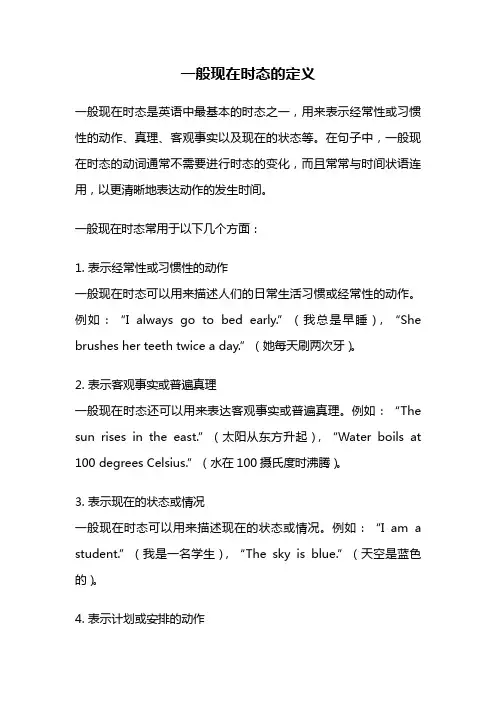
一般现在时态的定义一般现在时态是英语中最基本的时态之一,用来表示经常性或习惯性的动作、真理、客观事实以及现在的状态等。
在句子中,一般现在时态的动词通常不需要进行时态的变化,而且常常与时间状语连用,以更清晰地表达动作的发生时间。
一般现在时态常用于以下几个方面:1. 表示经常性或习惯性的动作一般现在时态可以用来描述人们的日常生活习惯或经常性的动作。
例如:“I always go to bed early.”(我总是早睡),“She brushes her teeth twice a day.”(她每天刷两次牙)。
2. 表示客观事实或普遍真理一般现在时态还可以用来表达客观事实或普遍真理。
例如:“The sun rises in the east.”(太阳从东方升起),“Water boils at 100 degrees Celsius.”(水在100摄氏度时沸腾)。
3. 表示现在的状态或情况一般现在时态可以用来描述现在的状态或情况。
例如:“I am a student.”(我是一名学生),“The sky is blue.”(天空是蓝色的)。
4. 表示计划或安排的动作一般现在时态还可以用来表示将来的计划或安排的动作。
例如:“We leave for the airport tomorrow.”(明天我们去机场),“The train arrives at 9 o'clock tonight.”(火车今晚9点到达)。
需要注意的是,一般现在时态还可以与一些时间状语连用,以更准确地表达动作的发生时间。
常见的时间状语有:always(总是)、usually(通常)、often(经常)、sometimes(有时候)、never (从不)等。
当我们使用一般现在时态时,还需要注意主语和动词的一致性。
对于第三人称单数的主语,动词的形式要加上-s或-es。
例如:“She loves playing the piano.”(她喜欢弹钢琴)。

一般现在时态一、一般现在时表示经常、习惯性发生的动作或存在的状态。
在一般现在时句中,如果主语是第三人称单数形式,谓语动词要相应地变为第三人称单数形式。
变化规则如下:1.+ s 2. 辅音+y,变y为i再加es: study-studies 3.以s,x,ch,sh结尾加es: watch-watches , teach-teaches 4特殊have-has ,do-does, go-goes二、一般现在时的用法1. 表示经常或反复发生的动作,常与always, often, usually, sometimes, never(从不),every day 等频度时间状语连用。
如:He often goes to school by bus. 他经常坐公交车上学。
We always have supper at 6:30 pm. 我们总是在晚上6点半吃晚饭。
2. 表示现在的状态、特征、能力和感觉。
这类动词有be, love, like, hate, want, know, have等。
如:He is very happy. 他很幸福。
(表示状态)She looks like her father. 她看上去像她爸爸。
(表示特征)3. 表示客观真理、科学事实和客观存在。
如:The sun rises in the east. 太阳从东方升起。
4. 表示天气、时间、旅程、籍贯等情况。
如:What's the weather like today? 今天天气如何?I'm from Shanghai. 我是上海人。
5.在时间状语从句和条件状语从句中,用一般现在时表示将来。
如:If it rains tomorrow, we'll stay at home. 如果明天下雨,我们就呆在家练习:1.I______(be) a student. My name_____(be) Tom.2. Where _____(be) my shoes? They___(be) here.3.Who ____(be) the girl with long straight hair? I think she ___(be) Kate.4. You and I ____________ (not be) in Class Six.5.___(be) there a supermarket on the Fifth Avenue? Yes, there_____(be).6. ____(be) her parent tall? No, he ____ (not be).7. Tom often __________(take) a talk after supper.8. Tom and I usually __________(go) to school by bike.9. Does Lin Tao __________(like) reading storybooks?10. What classes do you __________(have) today?11. How often does the girl __________(watch) TV?12. Where do they __________(live) now?13. Every year many people __________(lose) their lives in traffic accidents.14. They often play the piano loudly.(变否定句)They __________ often __________ the piano louldy.15. Jim learns English well.(变一般疑问)__________ Jim __________ English well?。


时态详解:一般现在时一、一般现在时表现在1.表示现在经常性或习惯性的动作。
如:My sister wears glasses. 我妹妹戴眼镜。
He often goes to the cinema. 他经常去看电影。
【注】询问某人的习惯时,有时还可用ever。
如:“Do you ever eat meat?” “No, I never eat meat.”“你吃肉吗?”“从不吃肉。
”2.表示现在(或经常性)的情况或状态。
如:Mother is ill. 母亲病了。
He is always like that. 他总是那样。
He likes living in the country. 他喜欢住在乡下。
We need a lot of money. 我们需要一大笔钱。
3.表示现在的能力、特征、职业等。
如:He sings well. 他唱歌唱得好。
Mr. Smith teaches French. 史密斯先生教法语。
4.表示客观真理、科学事实、格言以及不受时间限制的客观存在。
如:Summer follows spring. 春去夏来。
Knowledge is power. 知识就是力量。
The earth turns around the sun. 地球绕着太阳转。
二、一般现在时表将来1.当主句为将来时态或表示将来意义时,时间和条件的状语从句必须用一般现在时表将来。
如:I’ll write to her when I have time. 我有空会给她写信。
Turn off the lights before you leave. 走前关灯。
If we hurry, we may catch the bus. 如果赶紧走我们可能赶得上公共汽车。
Tell me in case you get into difficulty. 遇到困难请告诉我。
【注】①除表示时间和条件的状语从句外,表示让步、相似、比例的从句也必须用一般现在时表示将来。

小学英语语法时态一般现在时一般现在时(Simple Present Tense)是英语语法中最基本的一种时态,表示目前正发生的动作、存在的状态或经常性的动作。
以下是关于一般现在时的相关用法和规则。
一、动词的变化:一般现在时中,动词的第三人称单数形式(he、she、it等)需加上-s或-es。
例如:- I play football.(我踢足球。
)- She cooks dinner.(她做晚饭。
)- He watches TV.(他看电视。
)但是,以下情况除外:1. 当动词以某些字母结尾时,在动词后面直接加上-s,而不再加-es。
这些字母包括:-o(goes)、-ss(passes)、-x(fixes)、-ch(watches)、-sh(rushes)等。
例如:- She goes to school.(她去上学。
)- He passes the exam.(他通过了考试。
)2. 当动词以辅音字母+y结尾时,要将y改为i,再加-es。
例如:- He studies English.(他学习英语。
)- She tries her best.(她尽力。
)第1页/共4页3. 当动词以-e结尾时,只需加上-s。
例如:- They write letters.(他们写信。
)- He can dance.(他会跳舞。
)二、用法:1. 描述客观事实或经常性动作:一般现在时常用于描述客观事实或经常性动作。
例如:- Water boils at 100 degrees Celsius.(水沸腾的温度是100摄氏度。
)- I usually go to bed at 10 o'clock.(我通常在10点钟上床睡觉。
)2. 描述现阶段的状态:一般现在时还可用来描述现阶段的状态或对现实情况的评论。
例如:- They live in New York.(他们住在纽约。
)- She looks tired.(她看起来很累。
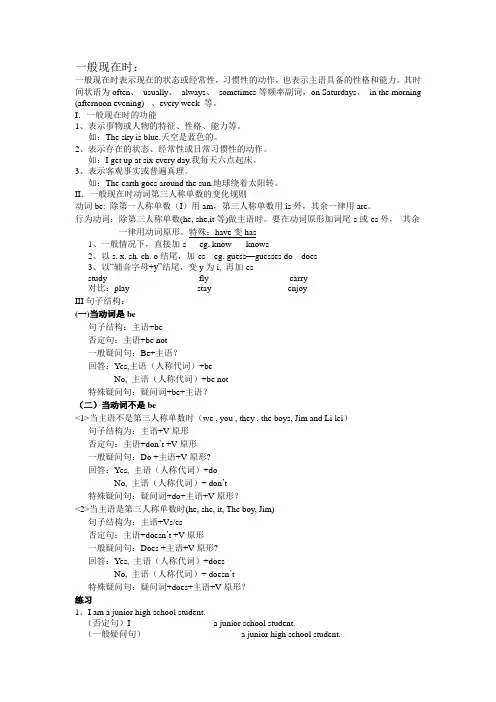
一般现在时:一般现在时表示现在的状态或经常性,习惯性的动作,也表示主语具备的性格和能力。
其时间状语为often、usually、always、sometimes等频率副词,on Saturdays、in the morning (afternoon evening) 、every week 等。
I.一般现在时的功能1、表示事物或人物的特征、性格、能力等。
如:The sky is blue.天空是蓝色的。
2、表示存在的状态、经常性或日常习惯性的动作。
如:I get up at six every day.我每天六点起床。
3、表示客观事实或普遍真理。
如:The earth goes around the sun.地球绕着太阳转。
II.一般现在时动词第三人称单数的变化规则动词be: 除第一人称单数(I)用am,第三人称单数用i s外,其余一律用are。
行为动词:除第三人称单数(he, she,it等)做主语时。
要在动词原形加词尾-s或-es外,其余一律用动词原形。
特殊:have变has1、一般情况下,直接加-s eg. know-----knows2、以s. x. sh. ch. o结尾,加-es eg. guess—guesses do---does3、以“辅音字母+y”结尾,变y为i, 再加-esstudy ________________ fly ________________ carry ________________对比:play _____________ stay _______________ enjoy ________________III句子结构:(一)当动词是b e句子结构:主语+be否定句:主语+be not一般疑问句:Be+主语?回答:Y es,主语(人称代词)+beNo, 主语(人称代词)+be not特殊疑问句:疑问词+be+主语?(二)当动词不是be<1>当主语不是第三人称单数时(we , you , they , the boys, Jim and Li lei)句子结构为:主语+V原形否定句:主语+don’t +V原形一般疑问句:Do +主语+V原形?回答:Y es, 主语(人称代词)+doNo, 主语(人称代词)+ don’t特殊疑问句:疑问词+do+主语+V原形?<2>当主语是第三人称单数时(he, she, it, The boy, Jim)句子结构为:主语+Vs/es否定句:主语+doesn’t +V原形一般疑问句:Does +主语+V原形?回答:Y es, 主语(人称代词)+doesNo, 主语(人称代词)+ doesn’t特殊疑问句:疑问词+does+主语+V原形?练习1、I am a junior high school student.(否定句)I __________________ a junior school student.(一般疑问句)______________________a junior high school student.(回答)Y es, __________________ / No, __________________.3、We have some books.(否定句)We________________________ books.(一般疑问句)____________________________ books ?(回答)Y es, _____________________ / No, _____________________.4、Mary likes Chinese.(否定句)Mary________________________ Chinese.(一般疑问句)____________Mary _________________ Chinese ? (回答)Y es, _____________________ / No, _____________________.5、He often reads books in the evening.(划线提问)__________________________________________________________。
时态:一般现在时1.一般现在时:表示通常性,规律性,习惯性的动作或者状态。
2.常用的时间状语:often经常,usually 通常,always总是,everyday(week, month, year)每天,每周,每月,每年,once a week 每周一次,sometimes 有时3 构成:动词原形:be 动词(am is are)情态动词(can may must will)行为动词(除了2种)主语是第三人称单数:a直接在动词后面加sb 以y结尾分两种情况,一种y前是元音a e i o u,直接加sy前是辅音要变y 为i加es,如playsc 以s, o, x, ch ,sh 结尾要加es, 如goes, washes, teaches, fixes, kisses4.否定形式:be not情态动词+not助动词do/does + not +行为动词1. We often______(play) in the playgound.2. He _____(get) up at six o’clock.3. _____you ______(brush) your teeth every morning.4. What (do) ______he usually (do)______ after school?5. Danny _____(study) English,Chinese,Maths,Science and Art an school.6. Mike sometimes ________(go) to the park with his sister.7. At eight at night, she __________(watch) TV with his parents.8. ________ Mike________(read) English every day?9. How many lessons_________your classmate________(have) on Monday?10. What time_________his mother_________(do) the housework?。
一般现在时态的定义一般现在时态是英语语法中的一个时态,用来描述目前正在发生或经常发生的动作、状态或习惯。
在句子中,一般现在时态通常由动词的基本形式表示,同时可以通过加上第三人称单数的变化来表示主语为第三人称单数。
一般现在时态可以用来描述以下几种情况:1. 经常性动作或习惯:一般现在时态常用来描述我们经常进行的动作或习惯。
例如:"I eat breakfast every morning."(我每天早上吃早餐。
)2. 客观事实:一般现在时态可以用来描述客观存在的事实。
例如:"The sun rises in the east."(太阳从东方升起。
)3. 普遍真理:一般现在时态可以用来表达普遍真理或常识。
例如:"Water boils at 100 degrees Celsius."(水在100摄氏度时煮沸。
)4. 感觉、态度或观点:一般现在时态可以用来表达感觉、态度或观点。
例如:"I love watching movies."(我喜欢看电影。
)5. 科学事实:一般现在时态可以用来描述科学事实或规律。
例如:"The earth revolves around the sun."(地球绕着太阳转。
)6. 计划或安排:一般现在时态可以用来描述将来的计划或安排。
例如:"I leave for London tomorrow."(我明天出发去伦敦。
)需要注意的是,一般现在时态并不仅限于描述现在的动作或状态,还可以用来描述将来的动作或状态,或者表达过去、现在和将来的惯例、习惯或规律。
在句子中,一般现在时态的动词变化规则如下:1. 对于大多数动词,一般现在时态的第三人称单数形式在动词原形后面加上-s或-es(如果动词以s、x、ch、sh或o结尾,则加上-es)。
例如:"He eats breakfast every morning."(他每天早上吃早餐。
一般现在时态一.一般现在时的定义表示经常反复发生的动作,经常存在的状态或者习惯性动作二.一般现在时基本结构1.be动词型肯定句:主语+ be动词(am/ is / are) + 其他.否定句:主语+ be动词(am/ is / are) + not + 其他.一般疑问句:Be动词(am/ is / are) + 主语+ 其他?2.行为动词型a.主语为I , You, We, They及可以被他们替换的词肯定句:主语(I / you/ we/ they) + 动词原形.否定句:主语(I / you/ we/ they) + don’t + 动词原形.一般疑问句:Do + 主语(I / you/ we/ they) + 动词原形?b.主语为He , She, It 及可以被他们替换的词。
肯定句:主语(He / She/ It) +动词三单.否定句:主语(He / She/ It) + doesn’t + 动词原形.一般疑问句:Does + 主语(he / she/ it) + 动词原形三.动词的第三人称单数形式变化规则。
变化规则1. 直接在动词后+ s : read-reads stop-stops2. 以s, x, ch, sh, o 结尾的词+ es: bus-buses box-boxes3.以辅音字母+y结尾的词,变y为i, 再加es :study-studies fly-flies4.不规则变化 : have-has三、用所给动词的一般现在时填空。
1. We often ______(play) in the playground.2. He ________(get) up at six o’clock.3. you (brush) your teeth every morning?4. What ___(do) he usually ______(do) after school?5. Danny _____(study) English, Chinese, Maths, Science, and Art an school.6. Mike sometimes _____ (go) to the park with his sister.7. At eight at night, she ________(watch) TV with his family.8. _____Mike _____(read) English every day?9. How many lessons ______ your classmate _____(have) on Monday?10. What time _____ his mother ______(do) the housework?四、按要求改写句子。
一般现在时态练习卷
一般现在时:表示经常性发生的事情
时间状语:often 经常,usually通常,always 总是,every每个,sometimes 有时,at …在几点钟
只有在第三人称单数用动词的“三单变化”,其他用动词的原形。
三单变化:1.多数在动词后+s play —plays like —likes
2.以s ,x ,sh ,ch , o 结尾的+es go —goes wash —washes 3.以辅音字母加y结尾,把y改成i 再加es fly —flies cry —cries
一.用动词的适当形式填空
1. She _________(go) to school at seven o’clock.
2. It’s 6 o’clock. They are _________ (eat) supper.
3. He usually ___________ up at 17:00.(get )
4. She ___________ (live) in Beijing.
5. Amy _________ (be) here just now.
6. _______ (be)there a fly on the table just now?
7. My father __________ (watch) TV every evening .
8. My father _______________ (make) toys these days.
9.________ Amy _________ (read) English every day
10. Chen Jie sometimes _________(go)to the park with her sister.
11. Mike_________ (like) cooking.
12. They _________ (have) the same hobby.
13. My aunt _________ (look) after her baby carefully.
14. You always _________ (do) your homework well.
15. I _________ (be) ill. I’m staying in bed.
16. She _________ (go) to school from Monday to Friday.
17. Liu Tao _________ (do) not like PE.
18. The child often _________ (watch) TV in the evening.
19. Wang Kai and Wang li_________ (have) eight lessons this term.
20. -What day _________ (be) it today?
-It’s Saturday.
21.You can't see her now; she _________(take) a shower.
22.My parents _________(grow)older and older.
23.He usually _________(drink)coffee ,
but today he ______ (drink)tea.
24.The children _________(have)a good time at the party very much right now.
25.A:How _________you usually _________(get )to work?
二.选择填空
1.I want____homework now.
A. doing
B. to do
C. to do my
D. do my
2.It's time______.
A. go to school
B. play games
C. to go home
D. to do my homework 3.____ you____the blackboard?Yes,I am.
A. Can, clean
B. Am, cleaning
C. Are, cleaning
D. Do clean 4.______go and help her.
A. Let's me
B. Let's us
C. Let's
D. Let's to
5.What are they doing? They are______things away.
A. put
B. putting
C. putting
D. carry
6.Do they have a new car? Yes,_____.
A .they are B.they have C. they don't D.they do
7.He often _________ supper at 6:00 in the evening.
A. have
B. has c. is having D. is eating
8. It’s 6 o’clock in the morning. He ___________.
A. get up
B. gets up
C. is getting up
D. is getting up
9. What are you doing? I’m __________ TV.
A. watch
B. watches
C. to watch
D. watching
10. We _____________ any Chinese classes on Friday.
A. are having
B. aren’t having
C. don’t have
D. are have
11. Tom _______ an English class now.
A. is having
B. has
C. having
D. have
12. Are you playing basketball? No, we ___________.
A. isn’t
B. aren’t
C. not
D. don’t
13. Listen! The girl _____________ in the room.
A. sings
B. singing
C. is singing
D. are singing
14. The boy is __________ to his teacher.
A. saying
B. speaking
C. talking
D. Telling
15. she read English every morning?
A.Is
B.Was
C.Does
D.Are
16.John football on the weekend.
A.play
B.plays
C.played
D.playing
17.Let her to the cinema tomorrow.
A.will go
B.go
C.goes
D.going
18.Look at the girl.She over there.
A.dancing
B.dances
C.dance
D.is dancing
19.
三、用括号内动词的适当形式填空。
1. He often _________ (have) dinner at home.
2. Daniel and Tommy _________ (be) in Class One.
3. We _________ (not watch) TV on Monday.
4. Nick_________ (not go) to the zoo on Sunday.
5. they _________ (like) the World Cup?
6. What they often_________ (do) on Saturdays?
7. your parents _________ (read) newspapers every day?
8. The girl _________ (teach) us English on Sundays.
9. She and I _________ (take) a walk together every evening.
10. There _________ (be) some water in the bottle.。